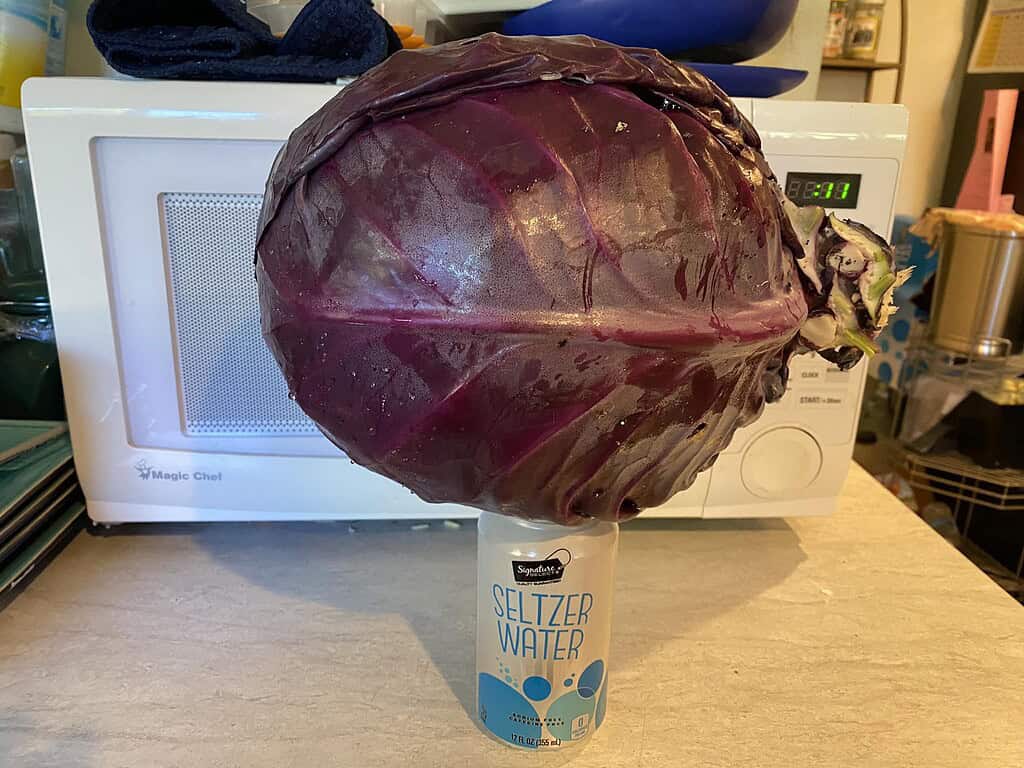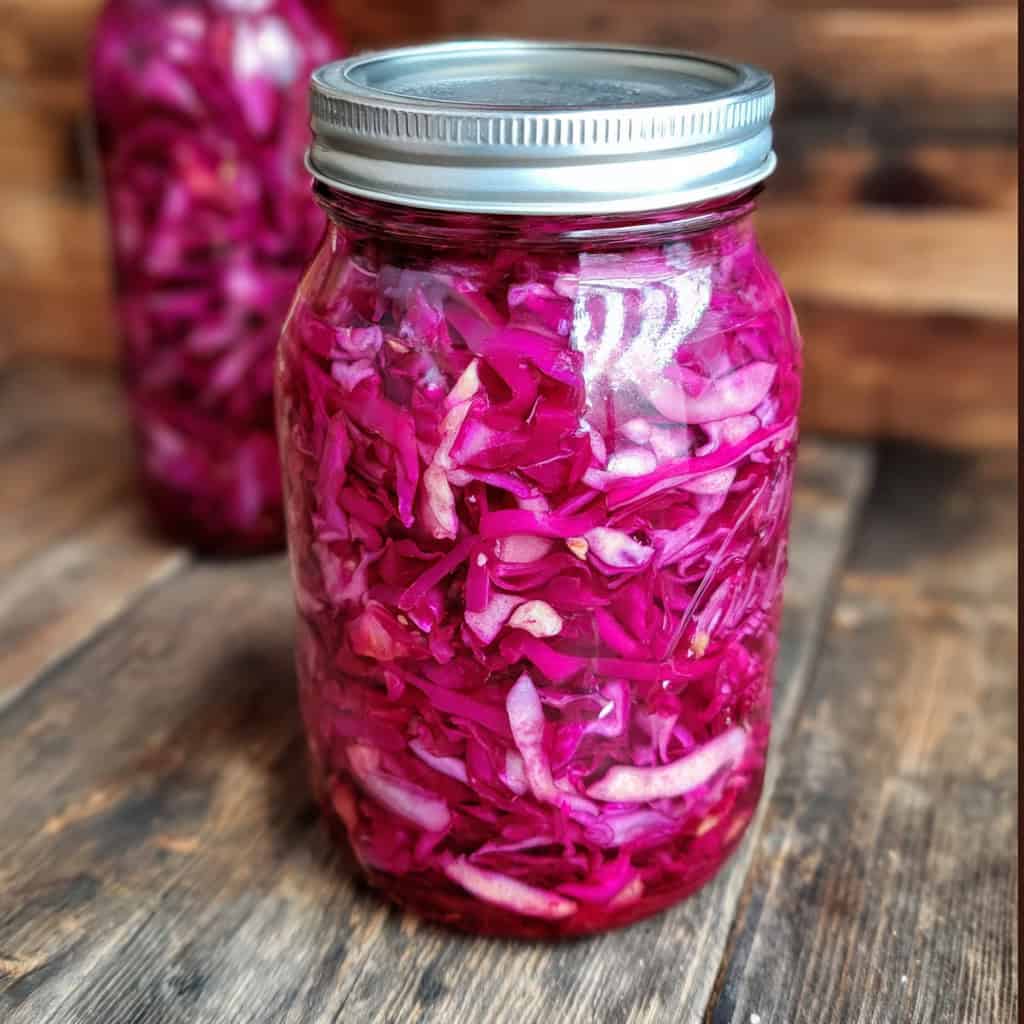There’s something about a jar of pickled cabbage that just brightens up a meal. It’s just cabbage, a bit of onion, some vinegar, and a few simple flavors that work magic together.
This quick recipe gives you crisp, tangy cabbage in no time, and you don’t even have to worry about canning or special tools.
With just a few everyday ingredients and a quick brine, you can have a jar of fresh, homemade pickled cabbage ready to enjoy in about 20 minutes.
For those interested in preserving more foods at home, check out our guide on canning for beginners. It’s a great resource if you’re looking to expand your pickling or canning skills.
It’s the kind of thing you can throw together while you’re cooking dinner, and by the time you sit down to eat, it’s ready to add that crunchy, flavorful kick to whatever’s on your plate.
Why You’ll Love This Recipe
Pickled cabbage is a simple way to add a punch of flavor to almost any meal.
This recipe is flexible, so you can swap ingredients based on what you have, like using green cabbage instead of red or honey instead of sugar.
Love Pickling? This is part of my How to Pickle Everything series! Check out more recipes:
- Quick Pickled Radishes Recipe
- Easy Pickled Beets Recipe
- Homemade Pickled Okra Recipe
- How to Make Pickled Jalapeños at Home
- How to Make Pickled Cucumbers at Home
- Pickled Garlic Recipe
- Easy Pickled Banana Peppers Recipe
- Quick Pickled Carrots Recipe
- How to Make Pickled Asparagus at Home
- How to Make Pickled Ginger (Gari) at Home
- How to Make Pickled Cauliflower
- Crisp Pickled Green Beans Recipe
- Homemade Pickled Eggs with Beets
- Easy Pickled Cherry Tomatoes (No Canning Needed)
You can also play around with spices (cumin, mustard seeds, or even peppercorns) to give it your own twist.
The best part is that it stays fresh in the fridge for up to two weeks, making it easy to pull out whenever you need something crunchy and tangy to liven up your plate.
Equipment Needed
- Cleaned and sanitized glass jars with tight‑fitting lids
- Small saucepan
- Knife and cutting board
- Measuring cups & spoons
- Spoon for packing
Ingredients (Makes ~6 servings)
- 6 cups shredded cabbage (red for color, green works too)
- 1 small onion, thinly sliced
- 1 garlic clove, lightly smashed
- 1 cup vinegar (5% acidity: apple cider, white, or rice)
- 1 cup water
- 2 tsp cane sugar (or honey/maple syrup)
- 1 tsp pickling/canning salt
- Optional spices: ½‑1 tsp of cumin seeds, mustard seeds, caraway, or peppercorns
About Vinegar & Acidity
When pickling, it is critical to use vinegar with 5% acidity (this will be printed on the label). Some brands now sell “reduced acidity” vinegar at 4% or less – these are not safe for pickling.
For refrigerator pickles, as with canned pickles, the vinegar-to-water ratio is what ensures that the vegetables are properly acidified and safe to eat.
Never reduce the amount of vinegar or increase the water in this recipe, even if you prefer a milder flavor.
If you’d like to soften the tang, you can balance the taste with a bit more sweetener, but the vinegar proportion must remain the same.
For more details on why acidity matters in pickling, see the NCHFP – General Pickling Information.
5 Simple Steps to Making Pickled Cabbage
Making pickled cabbage is simpler than it looks. Just follow these steps, and you’ll have a jar of tangy, crunchy cabbage ready in no time.
1. Prepare the Vegetables
Start by removing any tough or wilted outer leaves from the cabbage. Rinse the head of cabbage under cool running water to remove any soil or grit.
Cut the cabbage into quarters and carefully slice away the hard core at the center of each piece.
Place each quarter flat on your cutting board, then slice it crosswise into thin, even strips, aiming for a thickness similar to matchsticks.
Cutting the cabbage into thin, uniform pieces helps it absorb the brine quickly and evenly.
Next, peel your onion and slice it into thin half-moons. Lightly smash the garlic clove with the flat side of your knife – this helps release its flavor into the brine.
Divide the cabbage, onion, and garlic evenly into your clean jars, pressing them down gently so you can fit more inside without crushing the vegetables.
2. Make the Brine
Place a small saucepan on the stove and add the vinegar, water, sugar, salt, and any optional spices you’d like to use.
Stir everything together and turn the heat to medium. Warm the mixture just long enough for the sugar and salt to dissolve fully, stirring occasionally to help the process along.
You don’t need to let the brine come to a boil – gentle heating is enough. Once the sugar and salt are fully dissolved, remove the pan from the heat.
3. Pour Brine Over the Cabbage
Slowly and carefully pour the hot brine into each jar, letting it flow over the shredded vegetables. Use the back of a spoon to press down on the cabbage so that it is fully covered by liquid.
At first, the jars may seem a bit crowded, but that’s normal. The cabbage will soften slightly as it sits in the brine, allowing everything to settle and submerge properly.
4. Let the Mixture Cool
Set the jars on the counter and leave them uncovered until the contents have cooled completely to room temperature.
Allowing them to cool before sealing prevents condensation from forming inside the jars, which can dilute the brine and shorten shelf life. During this time, the flavors will also begin to meld.
5. Pack, Seal, and Refrigerate
Once the jars have cooled, check that the vegetables are still submerged in the brine. If any pieces are floating above the liquid, gently press them back down.
Close each jar with a clean, tight-fitting lid. Place the jars directly into the refrigerator.
The cabbage will taste lightly pickled after about an hour, but for best flavor, allow the jars to chill overnight.
The longer the cabbage sits in the fridge (up to two weeks), the more developed and balanced the flavors will become.
How to Store Your Pickled Cabbage
This is a refrigerator-only recipe.
Because this method uses a fresh-pack or quick-process brine (rather than full canning or fermentation), jars must be kept cold at all times to keep the pickles safe and crisp.
Quick-pickled cabbage should never be stored at room temperature or on a pantry shelf.
Container & Storage Tips
- Use clean, sanitized glass jars with airtight lids to store your pickled cabbage. Proper sanitation helps prevent unwanted microbial growth and preserves quality.
- Keep the jars in your refrigerator at or below 40 °F (4 °C). At this temperature, the cabbage will maintain its texture and flavor while staying safe to eat.
Shelf Life & Handling
- Quick‑pickled cabbage stays at best quality for about two weeks when continuously refrigerated. After that, you may notice changes in texture or flavor.
- Each time you take some cabbage out, use a clean utensil and press the remaining cabbage back down into the brine. Keeping the vegetables fully submerged helps maintain flavor, crunch, and prevents spoilage.
When to Discard
Do not attempt to save or reuse brine that shows signs of spoilage.
Always sniff your pickle before tasting. If the brine has turned cloudy, or there’s an unusual or off‑smell, discard the entire batch.
These signs may indicate yeast or other spoilage organisms – not safe to consume.
For more detailed food safety guidelines, visit the National Center for Home Food Preservation.
Serving Suggestions
Pickled cabbage adds a tangy crunch that can brighten up even the simplest meal. Here are some easy ways to use it:
- Tacos and Burritos: A spoonful of pickled cabbage adds crunch and a pop of color that pairs perfectly with grilled meats, fish, or beans.
- Burgers and Sandwiches: Use it in place of regular lettuce or slaw for extra flavor and texture.
- Grain Bowls: Mix it into rice or quinoa bowls along with roasted vegetables or proteins.
- Salads: Toss some into leafy green salads to give them a tangy edge.
- Grilled or Roasted Dishes: Serve it alongside grilled meats, sausages, or roasted vegetables as a quick, refreshing side.
- Breakfast Boost: Add a bit on the side of scrambled eggs or avocado toast for a flavorful kick.
Make a Batch!
Pickled cabbage is one of those easy recipes that can instantly upgrade your meals.
With just a handful of ingredients and a few minutes of work, you’ll have a jar of tangy, crunchy cabbage ready to add flavor to almost anything – from tacos to grain bowls.
Once you’ve made it once, you’ll see how simple it is to experiment with spices or other vegetables to make it your own.
Keep a jar in the fridge, and you’ll always have a quick way to bring life to everyday dishes!
Frequently Asked Questions (FAQs)
1. Can I use white vinegar instead of apple cider vinegar?
Yes, white vinegar works fine. It’s a bit sharper, so adding an extra pinch of sugar will help balance the flavor. You can also mix white vinegar with rice vinegar for a smoother taste.
2. How do I keep the cabbage crunchy?
The key is to slice the cabbage thin but not too thin and to pour the hot brine over it quickly. Always store it in the fridge and make sure the cabbage stays fully submerged in the brine.
3. Can I add other vegetables to the jar?
Definitely. Carrots, radishes, or thinly sliced peppers are great additions and pickle just as quickly as cabbage. Just keep the veggie slices about the same size so they all absorb the brine evenly.
4. Is there a way to make this less acidic?
You can reduce the vinegar slightly and add a bit more water, but remember that the vinegar is what preserves the cabbage and gives it its tang. Adding a little extra sweetener can also tone down the sharpness.
5. Why isn’t this recipe suitable for canning?
This is a quick-pickle recipe designed for the fridge, not for long-term storage. It doesn’t have the vinegar concentration or processing steps needed for safe canning. If you want to store it longer, make a fresh batch when needed.






